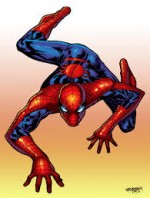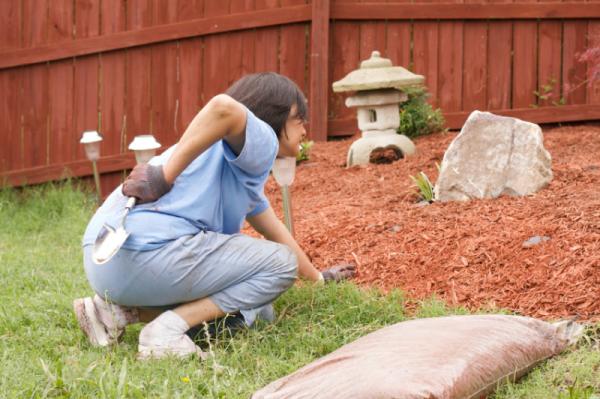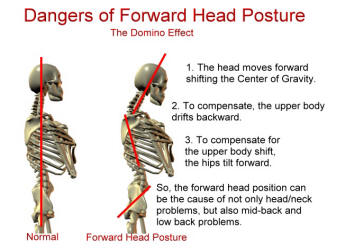Lucan Pilates Classes Crawling
Crawling as a Pilates exercise and movement pattern, I have introduced crawling into my Lucan Pilates classes as a warm up exercise.
Crawling is the first complex movement pattern that we learn as children. Crawling as an infant is very important to create strong shoulder and hip joints, co-ordination and core strength preparing us for walking.
Crawling teaches us functional core strength and movement. When crawling we are using our core muscles to stabilise our spine, hold our bodies in the air while also moving all our limbs. This is the way the core works naturally when running and swimming, which is in direct contrast to static exercises such as crunches and sit ups,
Types of crawls
There are various types of crawling and many newly named crawling patterns in primal movement circles, below are few:
Standard crawl
A typical crawl is left-hand, right-knee, right-hand, left-knee, or a hand, the diagonal knee, the other hand then its diagonal knee. This is the first gait most humans learn, and is mainly used during early childhood, or when looking for something on the floor or under low relief. This is the most natural of the crawls and is the one that requires the least effort.
Bear crawl: http://bcove.me/qy2l9ke2
The bear crawl is almost identical to the standard crawl, but the feet are used instead of the knees, which creates an arched or squatted body posture. This works as a faster crawl but requires more effort to maintain.
Crab crawl
The crab crawl is an upside down bear crawl. This is the most unnatural of the crawls, requiring the most effort, and is used in crab soccer. The crab crawl starts by sitting down with the feet and hands flat on the ground, the hips are then raised off the ground and the chest faces the sky.
Leopard crawl/High crawl
The leopard crawl is a military-specific crawl. This is a two-beat gait like a trot: an arm/elbow is advanced with the diagonal knee. This is designed for the smallest silhouette possible, and the body is often nearly or actually touching the ground, and although the elbow and knee are the main focus, most of the respective limbs touch the ground.
Tiger crawl
The tiger crawl is essentially a highly accelerated combination between crawl and leopard crawl. It uses the hands and the knees/feet depending upon the situation, while maintaining a silhouette almost as small as that of the leopard crawl. This is relatively fast gait but can take large amounts of energy.
Some of the benefits of crawling exercises:
- Strengthen hip & shoulder joints
- Unloads the spine
- Rich tactile, visual, & sensory input
- Fires almost every muscle in the body
- Stimulates both sides of the brain (co ordination)
- Works on reciprocal movement patterns
- Improves ability to dynamically control core muslces
- Takes advantage of primal movement system (“hard wired” in CNS)
Crawling is being used more and more as an exercise technique to help improve core strength, joint stability and co ordination among adults. Try it next time you are in the gym or working out in the local park, I use Spiderman Crawling as a warm up when training. http://youtu.be/_K7rv_vFOWM
Range of Motion Physical Therapy Sept Newsletter
|
Text Neck Syndrome
Believe it or not this is an actual syndrome, this term, text neck, was first coined by a chiropractor in Florida. It’s defined as overuse syndrome involving the head, neck and shoulders, usually resulting from excessive strain on the spine from looking in a downward position at hand held devices such as mobile phones, mp3 players, e-books and tablets.
I have written a number of blogs on posture and how important it is for those of you in office jobs to ensure you maintain a good posture during your working day. This issue is now starting to extend itself to all of us as we all increase our use of hand held devices and communicate by text.
 Irish people are amongst the biggest “texters” in the world. According to ComReg (2012), on average, over a billion text messages were sent every month in the first six months of 2012.
Irish people are amongst the biggest “texters” in the world. According to ComReg (2012), on average, over a billion text messages were sent every month in the first six months of 2012.
Texting is now a more popular method of communication in Ireland than making a phone call.
The most frequent texters in Britain are 12-15 year olds, who send an average of 193 texts a week - almost four times as many as the population as a whole.
As result, people who are frequently hunched over their mobile phones are more prone to experience headaches, neck pain and shoulder pain. The curving of the body to read and send text messages is subjecting people to these painful postural conditions.
The term Text Neck was developed to relate the pain to frequent texting. However, the condition has been around long before the first mobile phone. The more commonly known postural issue, Forward Head Posture is as a result of us being bent over our desks to glare at the computer screen all day.
 Unfortunately with the growing popularity of social media and mobile phones we are now not only spending 8 hours a day hunched over our desk in work, but also now spending every spare minute hunched over our phones after work.
Unfortunately with the growing popularity of social media and mobile phones we are now not only spending 8 hours a day hunched over our desk in work, but also now spending every spare minute hunched over our phones after work.
Preventing Text Neck / Forward Head Posture:
I am seeing more and more people with this condition, call it what you like Text Neck or Forward Head Posture, it is a very painful condition that needs quite a lot of time and effort for clients to reverse. Below are a couple of methods to help prevent the development of this postural issue.
- Modify the position of the device: If it is a phone try to hold it up at eye level, if it is a laptop in work again try to use a monitor placed at eye level.
- Take breaks: Be aware that you’re using these devices all day so force yourself to take a break and to change or alter your position.
- Physical fitness: Developing a strong, flexible back, neck and shoulders will help you deal with abnormal stresses and reduce postural issues. E.g. Pilates would be an ideal exercise to help maintain strength to help prevent these postural issue developing.
There are a few steps you can take to prevent text neck. Regular physical therapy for any ongoing pain is also advised. In addition, to getting expert advise on how to prevent future pain, I would also prescribe quick and easy daily exercises. I also teach correct posture both for the office and how to carry yourself on a daily basis.
If you would like to learn more or make an appointment please contact me at Range of Motion Physical Therapy, Lucan Dublin.
Range of Physical Therapy Aug Newsletter
|
|
||||||||||||||||||
|
||||||||||||||||||
Injury Prevention and Sports Massage for Runners
Injury Prevention: Sports Massage for Runners, Range of Motion Physical Therapy
With just over 3 months to go to the Dublin Marathon a lot of runners will be starting to focus on their marathon training. Most training plans will involve building your mileage gradually over the next 12 – 16 weeks. With that in mind, I am often asked when is the best time to get a sport massage when training for a marathon. In this blog I will give some advice and tips to bear in mind to help prevent any sports injuries while training, it is also important to build them into your training plan.
Some of the most common injuries I see from runners are ITB issues, Achilles tendinopathies, plantar fasciitis, stress fractures and common muscle strains.
The key benefits of getting a sports massage is to help improve circulation, balance the body’s musculoskeletal system, work out trigger points (knots) and reduce stress on joints. All of these factors will directly improve the ability to train regularly and improve your performance.
The difference between a sports massage and a massage at a spa, a sports massage will focus on the part of the body that is most often used by the athlete. It may also vary from upper to lower extremities, depending on the current issue. A sports massage is a deeper massage and will involve different techniques to help assist with muscle repair and recovery. I advise going to a therapist who runs or is active in sport so they understand the effects on the body from training regularly.
Runners who are training regularly and intensely should look to avail of a massage weekly, especially during peak training periods. For those on a budget, you can still get benefits from a monthly sports massage, preferably during an easy training week when the body is recovering and rebuilding. I would always recommend a pre- and post massages for 10K, half marathons and marathons etc.
If people can’t afford to get a sports massage regularly, I recommend using self-massage tools such as foam rollers, massage balls, etc. These tools can be used in conjunction with regular stretching. This maintenance program is important and should be considered part of your training plan. I also recommend people cross train to help the body recover and train, and give the body break from running e.g. pilates, swimming or cycling. Foam Rolling Video for the lower body.
The biggest problem that I see with running injuries is most people do not address them soon enough. I often get clients contacting me about a month after they started to experience a niggle or some pain. It normally means they have been trying to run off the injury?? (which makes loads of sense) or they feel it will resolve over time or they take a short break but go back to the regular training plan (to much to soon).
Unfortunately by the time they come to me the injury has now become a bigger problem and they can no longer run without pain. This is turn means it will take longer for the injury to resolve, it is so important to seek help if you feel a niggle that either causes pain while running, after running or does not resolve within a week.
So my best tip for sports injury prevention would be to create a maintenance program of foam rolling and stretching, cross train to give the body a break and get regular sports massages. Also if you feel an issue developing, seek help straight away. I hate to see clients who have invested months of time and effort training but ignore body maintenance and injury until it is too late.
If you would like to learn more or book a sports massage please contact me at Range of Motion Physical Therapy, Lucan Dublin.
Range of Motion Physical Therapy July Newsletter
|
|
|||||||||||||
|
|||||||||||||
Are you suffering from chronic shoulder pain or a rotator cuff injury?
The problem may not be the rotator cuff, you may have a S.I.C.K. scapula!
Here's what to look for:
- Are you an Overhead Athlete? (Swimming, Tennis, Weightlifting etc)
- Do you have heaviness in your arm when doing overhead activities?
- Have you ever experienced dead arm or sensations travelling down the arm?
- Do you suffer from Shoulder Impingement or Rotator Cuff injury?
- Do you have a desk job and suffer from sore shoulders when exercising?
If yes to any of these questions, you may have a S.I.C.K. Scapula.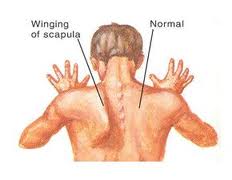
Also, if you are diagnosed with a rotator cuff injury that is not getting better, despite the rotator cuff exercises you are doing, it maybe your scapula that is the problem.
S.I.C.K. Scapula:
S: Scapular malposition on the rib cage
I: Inferior medial border winging from weak middle and lower trapezius muscles
C: Coracoid pain and malposition from the attachment of a tight Pectoralis minor muscle pulling on the coracoid
K: Scapular dyskinesis from alterations in muscle recruitment patterns
Many of the above findings are also present in recreational athletes, office workers and those working with computers. The typical posture when sitting at your desk is the head tilted forward and down, shoulders rolled forward and arms stretched out in front of you.
This posture causes tightening of the pectoralis muscles in the chest, the shoulders are pulled and rolled forward. The lower trapezius muscle are weakened due to the lack of use and being under constant stretch from the rounded shoulders.
As a result of these tight and weak muscles, the shoulder blades do not sit properly on the rib cage, thus there will be poor movement patterns of your shoulders, when you move your arms.
Now you can see why it is not only athletes that can suffer from this type of condition. A SICK scapula will result in Scapular Dyskinesis, which is an alteration in the normal position or motion of the scapula during shoulder movements. It occurs in a large number of shoulder injuries and appears to be a nonspecific response to shoulder dysfunction.
How to treat a SICK Scapula?
If you have been doing rotator cuff strengthening exercises with rubber tubing and you still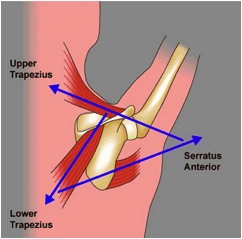 have shoulder pain, you may need to address the muscles that help hold that shoulder blade on your ribcage.
have shoulder pain, you may need to address the muscles that help hold that shoulder blade on your ribcage.
The trapezius, rhomboid and serratus anterior muscles must be properly synchronised to ensure smooth scapular motion during arm movement. Without a strong base of support to work from, the rotator cuff will not be able to fully recover. The shoulder and arm can only get as strong as the muscles that hold the shoulder blade onto your body.
The best treatment for this condition is physical therapy that incorporates soft tissue techniques, dry needling and rehabilitation that includes corrective exercises.
Some sample exercises that help focus strengthening the muscles around the scapula are what are called Y’s T’s W’s.
While strengthening these muscles it is important to stretch the tight muscles; posterior shoulder capsule and Pectoral muscles.
If you want to learn more about this issue or want to book an assessment and treatment, please contact Range of Motion Physical Therapy, Lucan Co Dublin.
Gardening is a Dangerous Sport!!
In the past few weeks I have had a number of clients requiring treatment as a result of gardening. With the improvement in weather, we are all eagerly hitting the garden with shovels and hedge trimmers, and being to gung-ho.
I have seen a number of injuries ranging from low back strains to hip and shoulder injuries. Like all manual exercise you need to build into it and warm up to it.
I have included a few simple tips to help prevent injuries while tackling those weeds:
- Do some gentle stretching before you start gardening to warm up muscles and joints.
- Kneel down when planting and weeding, placing knees on a cushion or knee pads.
- If you are digging, use a small spade so you don't have to pick up too much, thereby putting less strain on the back. Always keep the shovel close to your body, your knees slightly bent, and scoop in a forward motion, avoid twisting.
- Vary tasks regularly rather than doing hours of repetitive movement such as weeding. Take time to stretch every 5 – 10 minutes.
- When lifting, be it a small plant or a heavy bag of rubbish, bend your knees and keep your back straight, both when picking up and putting down. Avoid twisting the back by facing the direction in which the load is to be carried.
- If using a hover mower, you should push it in front of you and face the direction in which you are cutting the grass, rather than swinging it from side to side.
- Finally, never continue any activity if your back hurts or you have injured yourself. Try not to do more than one and a half to two hours per day, and work up slowly to longer days.
If you have been unlucky enough to injury yourself please contact Range of Motion Physical Therapy, Dublin for a an assessment and treatment.
When is Shoulder Pain not Shoulder Pain
I have been treating a client for the past 2 weeks who came to me be complaining of left shoulder pain. It all started two weeks ago when she lifted a heavy bucket off a table. The client reported that the pain got worse towards the end of the day and was aggravated when she lies on her shoulder. She was also saying the pain was referring into her first 3 fingers in the form of pins and needles and some numbness. The pain was not improving with rest....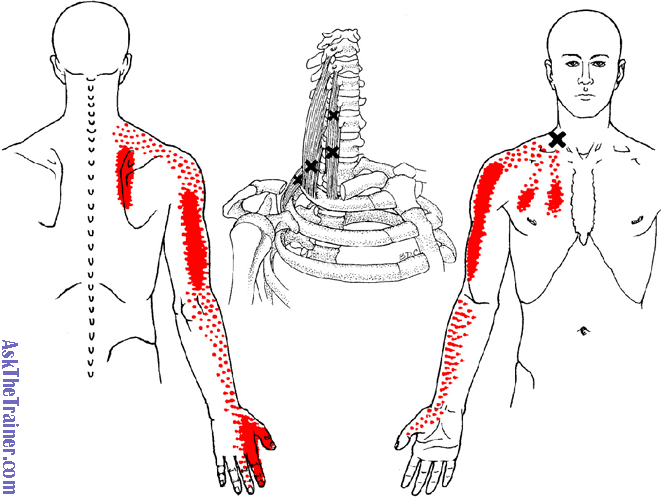
On examination she had pain on moving her shoulder and when she flexed, side bent and rotated her neck to the left. She also had very tight muscles in her neck, among other positive tests which were all consistent with a neck injury.
In particular her Scalene muscle was very tight and when i pressed on it it caused the same referral pain into her fingers. The Scalene muscles are located in the neck and attaches to the ribs, they assists with breathing and side bending the Neck. As per the image below, evidence shows that tight scalene muscles can refer pain down the arm to the fingers.
My initial treatment involved soft tissue massage to the neck and shoulder muscles, some gentle mobilisation to the neck and shoulder region. I also used Dry Needling on the upper traps and to the scalene muscle, this was all supported with Kinesio taping to the shoulder to help improve posture. I also prescribed some exercises to help improve her posture and strengthen the scalene muscle.
On her 2nd appointment she reported just slight numbness in her index finger, she could now lie on the shoulder and movement was pain free.
I repeated a similar treatment and gave some progressive exercises... She cancelled her 3rd appointment as her symptoms had resolved fully.
Neck Pain and Deep Neck Flexors
Neck Pain and Deep Neck Flexor Exercises, Range of Motion Physical Therapy Clinic Dublin
I see a lot of clients suffering from acute or chronic neck pain. Some of the incidents of acute neck pain are caused by whiplash injuries and more subtle injuries such as lifting objects incorrectly or jarring neck muscles.
Clients who suffer a whiplash injury and do not seek treatment can suffer from Chronic Neck Pain later in life, due to weakness and imbalance of the neck muscles.
Chronic neck pain can also be caused by poor posture, a number of clients suffer from Forward Head Posture (FHP) and Rounded Shoulders. Forward head posture is as a result of the deep neck flexor muscles at the front of your neck becoming tight, while the posterior cervical muscles at the back of the neck are shorten and weakened, causing the head to be pulled forward. Typically this posture is accompanied by rounded shoulders, placing further pull and tightness on the shoulders and upper back (Upper Cross Syndrome).
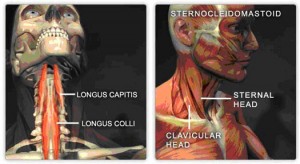 When treating this type of neck pain it is important to focus on the deep Neck Painneck flexor muscles (DNF); include the longus capitus and colli, while also looking to release the sternocleidomastoid with the posterior cervical muscles.
When treating this type of neck pain it is important to focus on the deep Neck Painneck flexor muscles (DNF); include the longus capitus and colli, while also looking to release the sternocleidomastoid with the posterior cervical muscles.
In order to ensure muscle balance between the anterior and posterior aspect of the neck it is important to have sufficient motor control of the two groups of muscles.
These two exercises have been identified as the best early stage exercises to help recruit and strengthen the DNF while also helping to lengthen the posterior cervicals.
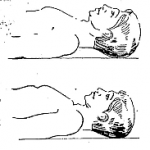 Exercise 1: Chin TuckChin Tuck for Neck Pain
Exercise 1: Chin TuckChin Tuck for Neck Pain
This exercises is best started lying down with your knees bent up.
In order to complete the exercise simply draw your chin down towards the floor, causing a slight nod of the head.
Hold for 5 – 10 secs and repeat 5 – 10 times, twice a day.
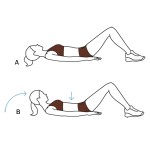 Exercise 2: Head liftNeck Exercise
Exercise 2: Head liftNeck Exercise
This exercise is a slight progression from the chin tuck.
In the same starting position, simply lift your head of the floor 3-4″
Hold for a couple of seconds and repeat 10 times
Both these exercise help build strength and endurance and enable you to switch on and gain control of the muscle groups. These exercises would also be accompanied by some shoulder exercises, such as scapula pinches to assist with the stabilisation of the neck.
These exercises should be performed pain free, if they cause any pain stop the exercise and contact a Range of Motion Physical Therapy Lucan Dublin for further assistance.


